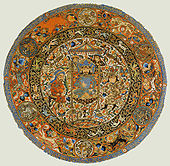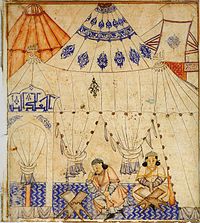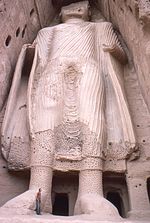- Ilkhanate
-
Ilkhanate
سلسله ایلخانی← 
←
←
1256–1335 ↓ Flag of Il-Khanate[citation needed]
Ilkhanate at its greatest extent Capital Maragheh, Tabriz, and Soltaniyeh Language(s) Middle Mongolian—Official:
civil administration, court, diplomatic talks, governmental announcements, international contacts, theological discourse, court-based religious posts[1]
Persian—Official: educational, high court, military usage, literary, spoken by majority of public[1]
TurkicReligion Buddhism, Shamanism, and then later Twelver Shia Islam Government Monarchy Ruler - 1256–1265 Hulagu Khan - 1316–1335 Abu Sa'id Legislature Kurultai History - Established 1256 - Disestablished 1335 Area - 1310 est. 3,750,000 km2 (1,447,883 sq mi) Preceded by Succeeded by 
Mongol Empire Khwarezmid Empire 
Abbasid Caliphate Chobanids 
Jalayirids 
Eretnids 
Muzaffarids 
Injuids 
Sarbadars 
Timurid Empire 
Mamluks 
History of Iran
see also Kings of Persia · Timeline of IranAntiquity Prehistory Proto-Elamite period 3200–2800 Elamite dynasty 2800–550 Kassites 16th–12th cent. Mannaeans 10th–7th cent. Median Empire 728–550 Achaemenid Empire 550–330 Seleucid Empire 330–150 Parthian Empire 248 BCE–226 CE Sassanid Empire 226–651 Middle Ages Islamic conquest 637–651 Umayyad Caliphate 661–750 Abbasid Caliphate 750–1258 Tahirid dynasty 821–873 Alavid dynasty 864–928 Sajid dynasty 889/890–929 Saffarid dynasty 861–1003 Samanid dynasty 875–999 Ziyarid dynasty 928–1043 Buyid dynasty 934–1062 Sallarid 942–979 Ma'munids 995-1017 Ghaznavid Empire 963–1187 Ghori dynasty 1149–1212 Seljuq dynasty 1037–1194 Khwarezmid dynasty 1077–1231 Ilkhanate 1256–1353 Muzaffarid dynasty 1314–1393 Chupanid dynasty 1337–1357 Sarbadars 1337–1376 Jalayerid dynasty 1339–1432 Timurid dynasty 1370–1506 Qara Qoyunlu 1407–1468 Aq Qoyunlu 1378–1508 Modern history Safavid dynasty 1501–1722/36 Hotaki dynasty 1722–1729 Afsharid dynasty 1736–1750 Zand dynasty 1750–1794 Qajar dynasty 1781–1925 Pahlavi dynasty 1925–1979 Interim Government 1979–1980 Islamic Republic since 1980
edit The Ilkhanate, also spelled Il-khanate (Mongolian: Hülegü-yn Ulus; Mongolian Cyrillic: Хүлэгийн улс; Azerbaijani: Hülakülər dövləti; Persian: سلسله ایلخانی), was a Mongol khanate established in Azerbaijan and Persia in the 13th century, considered a part of the Mongol Empire. The Ilkhanate was based, originally, on Genghis Khan's campaigns in the Khwarezmid Empire in 1219–1224, and founded by Genghis's grandson, Hulagu, in what territories which today comprise most of Iran, Iraq, Afghanistan, Turkmenistan, Armenia, Azerbaijan, Georgia, Turkey, and some regions of western Pakistan. The Ilkhanate initially embraced many religions, but was particularly sympathetic to Buddhism and Christianity. Later Ilkhanate rulers, beginning with Ghazan in 1295, embraced Islam.
Contents
Definition
According to the historian Rashid-al-Din Hamadani, Kublai granted Hulagu (Hulegu) the title of Ilkhan after his defeat of Ariq Boke. The term il-Khan means "subordinate khan" and refers to their initial deference to Möngke Khan and his successor Great Khans of the entire empire. The title "Ilkhan", borne by the descendants of Hulagu and later another Borjigin princes in Persia, does not materialize in the sources until after 1260.[2]
Early Mongol rule in Persia
When Muhammad II of Khwarezm executed the merchants dispatched by the Mongols, Genghis Khan declared war on Khwārazm-Shāh dynasty in 1219. The Mongols overran the whole empire, occupying all major cities and centers between 1219 to 1221. Persian Iraq was ravaged by the Mongol detachment under Jebe and Subedei, they left the area in ruin. Transoxiana came under the Mongol control after the invasion. The undivided area west of the Transoxiana was the inheritance of Genghis Khan's Borjigin family.[3] Thus, families of the latter's four sons appointed their officials under the Great Khan's governors, Chin-Temur, Nussal and Korguz, there.
Muhammad's son Jalal ad-Din Mingburnu returned to Iran in c.1224 after his exile in India. Rival Turkic states remained of his father's empire quickly declared their allegiance to him. He repulsed the first Mongol attempt to take Central Persia. However, Jalal ad-Din was overwhelmed and crushed by Chormaqan's army sent by the Great Khan Ögedei in 1231. During the Mongol expedition, Azerbaijan and southern Persian dynasties in Fars and Kerman voluntarily submitted to the Mongols and agreed to pay tributes.[4] To the west, Hamadan and the rest of Persia was secured by Chormaqan. The Mongols turned their attention to Armenia and Georgia in 1234 (or 1236). They completed the conquest of the Kingdom of Georgia in 1238; however, the Mongol Empire began to attack western parts of Greater Armenia which was under the Seljuks the next year.
In 1236 Ogedei commanded to raise up Khorassan and populated Herat. The Mongol military governors mostly made their camp in Mughan plain, Azerbaijan. Realizing the danger of the Mongols, rulers of Mosul and Cilician Armenia submitted to the Great Khan. Chormaqan divided the Transcaucasia region into three districts based on military hierarchy.[5] In Georgia, the population were temporarily divided into eight tumens.[6] By 1237 the Mongol Empire had subjugated most of Persia, excluding Abbasid Iraq and Ismaili strongholds, and all of Afghanistan and Kashmir.[7]
After the battle of Köse Dağ in 1243, the Mongols under Baiju occupied Anatolia, and the Seljuk Sultanate of Rûm and the Empire of Trebizond became vassals of the Mongols.[8]
Guyuk Khan abolished decrees, issued by the Mongol princes, had given orders on the revenue of districts in Persia and given also orders of exemption to others in c.1244.[9]
In accordance with the governor Arghun the Elder's (Arghun agha) complaint, Mongke Khan prohibited ortog-merchants and nobles to abuse relay stations, yam (route), and civilians in 1251.[10] He ordered a new census and decreed that each man in the Mongol ruled-Middle East must pay in proportion to his property. Persia was divided between four districts under Arghun. Mongke Khan granted the Kartids authority over Herat, Jam, Bushanj, Ghor, Khaysar, Firuz-Kuh, Gharjistan, Farah, Sistan, Kabul, Tirah, and Afghanistan (the Sulaiman Mountains) all the way to the Indus River.[11]
First Ilkhan
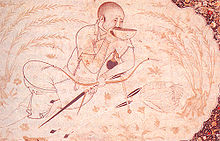 Hulagu Khan, Genghis Khan's grandson and founder of the Ilkhanate.
Hulagu Khan, Genghis Khan's grandson and founder of the Ilkhanate.
The actual founder of the Ilkhanate dynasty was Hulagu Khan, grandson of Genghis Khan and brother of both Möngke Khan and Kublai Khan. Möngke dispatched him to establish a firm Toluid control over the Middle East, and ordered him return to Mongolia when his task was accomplished.[12] Taking over from Baiju in 1255 or 1256, he had been charged with subduing the Muslim kingdoms to the west "as far as the borders of Egypt." This occupation led the Turkmens to move west into Anatolia to escape from the Mongolian tribes. He established his dynasty over the southwestern part of the Mongol Empire that stretched from Transoxiana to Syria. He destroyed the Ismaili Nizari Hashshashins and the Abbasid Caliphate in 1256 and 1258 respectively. After that he advanced as far as Gaza, briefly conquering Ayyubid-Syria.
Möngke's death forced Hulagu to return from the Persian heartland for the preparation of Khuriltai (selection of a new leader). He left a small force behind to continue the Mongol advance, but it was halted in Palestine in 1260 by a major defeat at the battle of Ain Jalut at the hands of the Mamluks of Egypt. Due to geo-political and religious issues and deaths of three Jochid princes in Hulagu's service, Berke declared open war on Hulagu in 1262 and possibly called his troops back in Iran. According to Mamluk historians, Hulagu might have massacred Berke's troops and refused to share his war booty with Berke.
Hulagu with his Christian queen Doquz Khatun.
The Yuan Dynasty in the east maintained a friendly relationship and held nominal suzerainty over the Ilkhanate until the fall of the latter in the 1330s.[13][14] Hulagu's descendants ruled Persia for the next eighty years, tolerating multiple religions including Shamanism, Buddhism, and Christianity, ultimately adopting Islam as a state religion in 1295. However, despite this conversion, the Ilkhans remained opposed to the Mamluks (who had defeated both Mongol invaders and Crusaders). The Ilkhans launched several invasions of Syria, but were never able to gain and keep significant ground against the Mamluks, eventually being forced to give up their plans to conquer Syria, along with their stranglehold over their vassals the Sultanate of Rum and the Armenian kingdom in Cilicia. This was in large part due to civil war in the Mongol Empire, and the hostility of the khanates to the north and east. The Chagatai Khanate in Moghulistan and the Golden Horde threatened the Ilkhanate in the Caucasus and Transoxiana, preventing expansion westward. Even under Hulagu's reign, the Ilkhanate was engaged in open warfare in the Caucasus with the Mongols in the Russian steppes.
Hulagu took with him many Chinese scholars, astronomers, and the famous Persian astronomer Nasir al-Din al-Tusi learned about the mode of the Chinese calculating tables.[15] The observatory was built on a hill of Maragheh.
Franco-Mongol alliance
Main article: Franco-Mongol allianceMany attempts towards the formation of a Franco-Mongol alliance were made between the courts of Western Europe (West Europeans were collectively called Franks by Muslims and Asians in the Crusades era) and the Mongols (primarily the Ilkhanate) in the 13th and 14th centuries, starting from around the time of the Seventh Crusade. United in their opposition to the Muslims (mainly the Mamluks), the Ilkhanate and the Europeans were still never able to satisfactorily combine their forces against their common enemy.[16]
Conversion to Islam
In the period after Hulagu, the Ilkhans increasingly adopted Tibetan Buddhism. Christian powers were encouraged by what appeared to be a favoring of Nestorian Christianity but this probably went no deeper than their traditional evenhandedness.[17] Thus the Ilkhans were markedly out of step with the Muslim majority they ruled. Ghazan, shortly before he overthrew Baydu, converted to Islam and his official favoring of Islam coincided with a marked attempt to bring the regime closer to the non-Mongol majority. Christian and Jewish subjects lost their equal status with Muslims and again had to pay the poll tax. Buddhists had the starker choice of conversion or expulsion.[18]
In foreign relations, the conversion to Islam had little to no effect and Ghazan continued to fight the Mamluks for control of Syria. But the Battle of Wadi al-Khazandar, which was the Mongols' only major victory over the Mamluks, disproved his control over Syria, which lasted but a few months. For the most part, Ghazan's policies continued under his brother Öljeitü despite suggestions that he might begin to favor the Shi'a brand of Islam after he came under the influence of Shi'a theologians Al-Hilli and Maitham Al Bahrani.[19] Öljeitü succeeded in conquering Gilan on the Caspian coast and his magnificent tomb in Soltaniyeh remains the best known monument of Ilkhanid rule in Persia.
Disintegration
After Abu Sa'id's death in 1335, the khanate began to disintegrate rapidly, and split up into several rival successor states, most prominently the Jalayirids. Hasar's descendant Togha Temür, who was the last of the obscure Ilkhan pretenders, was assassinated by Sarbadars in 1353. Timur later carved a state from the Jalayirids, ostensibly to restore the old khanate. The historian Rashid-al-Din Hamadani wrote a universal history for the khans around 1315 which provides much material for their history.
Legacy
History of the Mongols 
Before Genghis Khan Khamag Mongol Mongol Empire Khanates - Chagatai Khanate - Golden Horde - Ilkhanate - Yuan Dynasty Northern Yuan Timurid Empire Mughal Empire Crimean Khanate Khanate of Sibir Zunghar Khanate Mongolia during Qing Outer Mongolia (1911-1919) Republic of China (Occupation of Mongolia) Mongolian People's Republic (Outer Mongolia) Modern Mongolia Mengjiang (Inner Mongolia) People's Republic of China (Inner Mongolia) Republic of Buryatia Kalmyk Republic Hazara Mongols Aimak Mongols Timeline edit box The emergence of Ilkhanate had an important impact in this region. The Mongol Empire had significantly eased trade and commerce across Asia. The communications between Ilkhanate and the Yuan Dynasty in China encouraged this development.[20][21]
The Ilkhanate also helped to pave the way for the later Safavid dynastic state, and ultimately the modern country of Iran. Hulagu's conquests had also opened Iran to Chinese influence from the east. This, combined with patronage from his successors, would develop Iran's distinctive excellence in architecture. Under the Il Khans, Iranian historians also moved from writing in Arabic, to writing in Persian.[22]
Ilkhans
House of Hulagu (1256-1335).Ilkhanate Mongol kings
- Hulagu Khan (1256–1265)
- Abaqa Khan (1265–1282)
- Ahmad Tegüder (1282–1284)
- Arghun (1284–1291)
- Gaykhatu (1291–1295)
- Baydu (1295)
- Mahmud Ghazan (1295–1304)
- Muhammad Khodabandeh (Oljeitu) (1304–1316)
- Abu Sa'id Bahadur (1316–1335)
After the Ilkhanate, the regional states established during the disintegration of the Ilkhanate raised their own candidates as claimants.
House of Ariq Böke
- Arpa Ke'ün (1335–1336)
House of Hulagu (1336-1357)
- Musa (1336–1337) (puppet of 'Ali Padshah of Baghdad)
- Muhammad (1336–1338) (Jalayirid puppet)
- Sati Beg (1338–1339) (Chobanid puppet)
- Sulayman (1339–1343) (Chobanid puppet, recognized by the Sarbadars 1341–1343)
- Jahan Temur (1339–1340) (Jalayirid puppet)
- Anushirwan (1343–1356) (Chobanid puppet)
- Ghazan II (1356–1357) (known only from coinage)
House of Hasar
Claimants from eastern Persia (Khurasan):
- Togha Temür (c. 1338–1353) (recognized by the Kartids 1338–1349; by the Jalayirids 1338–1339, 1340–1344; by the Sarbadars 1338–1341, 1344, 1353)
- Luqman (1353–1388) (son of Togha Temür and the protege of Timur)
Family tree (House of Hulagu)
Temüjin Börte Ujin
(b.1162-d.1230)Tolui
(b.1193-d.1232)Sorghaghtani Beki
(b.1198-d.1252)1
Hulagu Khan
(b.1217-d.1265)
Ilkhan
1256-1265Doquz Khatun
(d.1265)3
Tekuder
(b.1233-d.1284)
Ilkhan
1282-12842
Abaqa Khan
(b.1234-d.1282)
Ilkhan
1262-1282Trqay Mengu Timur 4
Arghun
(b.1258-d.1292)
Ilkhan
1284-12915
Gaykhatu
(d.1295)
Ilkhan
1291-12956
Baydu
(d.1295)
Ilkhan
1295Ambarji 7
Ghazan
(b.1272-d.1304)
Ilkhan
1295-13048
Oljaitu
(b.1280-d.1316)
Ilkhan
1304-1316Alafireng Ali Timur 15
Sati Khatun
(c.1300-1345)
Ilkhan
1338-13399
Abu Sa'id
(b.1305-d.1335)
Ilkhan
1316-133514
Jahan Timur
Ilkhan
1339-134010
Musa
(d.1336)
Ilkhan
1336-1337Yul Qotloq 12
Muhammad
(d.1338)
Ilkhan
1336-1338See also
- Full list of Iranian Kingdoms
- Sarbadars, the famous political movement of the Ilkhanid era of Persia.
- Hazaras
Notes
- ^ a b Rahiminejad, Sadegh: IRAN: Tarikh (2006). Languages of the Persian [Section]
- ^ Peter Jackson - The Mongols and the west, p.127
- ^ Jeremiah Curtin-The Mongols: A history, p.184
- ^ Timothy May-Chormaqan, p.47
- ^ Grigor of Akanc-The history of the nation of archers, (tr. R.P.Blake) 303
- ^ Kalistriat Salia-History of the Georguan Nation, p.210
- ^ Thomas T. Allsen-Culture and Conquest in Mongol Eurasia, p.84
- ^ George Finlay- The history of Greece from its conquest by the Crusaders to its conquest by the Ottomans, p.384
- ^ C.P.Atwood-Encyclopedia of Mongolia and the Mongol Empire, see:Monqe Khan
- ^ M. Th. Houtsma-E.J. Brill's first encyclopaedia of Islam, 1913-1936, Volume 1 , p.729
- ^ Ehsan Yar-Shater- Encyclopaedia Iranica, p.209
- ^ P.Jackson-Dissolution of the Mongol Empire, pp.222
- ^ Christopher P. Atwood - Ibid
- ^ Michael Prawdin, Mongol Empire and its legacy, p.302
- ^ H.H.Howorth-History of the Mongols, vol.IV, p.138
- ^ "Despite numerous envoys and the obvious logic of an alliance against mutual enemies, the papacy and the Crusaders never achieved the often-proposed alliance against Islam". Atwood, Encyclopedia of Mongolia and the Mongol Empire, p. 583, "Western Europe and the Mongol Empire"
- ^ Medieval Persia 1040–1797, David Morgan p64
- ^ Medieval Persia 1040–1797, David Morgan p72
- ^ Ali Al Oraibi, Rationalism in the school of Bahrain: a historical perspective, in Shīʻite Heritage: Essays on Classical and Modern Traditions By Lynda Clarke, Global Academic Publishing 2001 p336
- ^ Gregory G.Guzman - Were the barbarians a negative or positive factor in ancient and medieval history?, The historian 50 (1988), 568-70
- ^ Thomas T.Allsen - Culture and conquest in Mongol Eurasia, 211
- ^ Francis Robinson, The Mughal Emperors and the Islamic Dynasties of India, Iran and Central Asia, Pages 19 and 36
References
- Atwood, Christopher P. (2004). The Encyclopedia of Mongolia and the Mongol Empire. Facts on File, Inc. ISBN 0-8160-4671-9.
- C.E. Bosworth, The New Islamic Dynasties, New York, 1996.
- R. Amitai-Preiss: Mongols and Mamluks: The Mamluk-Ilkhanid War 1260–1281. Cambridge, 1995
External links
- Ilkhanids Dynasty Mongolian dynasty
- Encyclopedia Iranica. Contains more information on the Ilkhanate.
- [1] Contains a searchable database for Ilkhanid coins
---
History of Azerbaijan 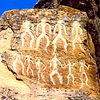
This article is part of a seriesAntiquity Ancient history and Roman era Atropatene First Persian Empire
and Alexander's conquestsCaucasian Albania Middle Ages Islamic period Seljuk dynasty Atabegs of Azerbaijan Ilkhanate Qara Qoyunlu Aq Qoyunlu Shirvanshahs Classical history Safavid dynasty Khanates Qajar dynasty Russian Rule Early independence History of the name Azerbaijan Azerbaijan Democratic Republic March Days Soviet Azerbaijan Azerbaijan SSR Black January Modern Azerbaijan Republic of Azerbaijan
Azerbaijan Portal
History of Turkey 
Seljuq dynasty 1071–1325 • Great Seljuq Empire 1071–1194 • Sultanate of Rum 1075–1307 • Under The Seljuks after 1071 Anatolian Beyliks • Artuqids 1098–1409 • Mengujekids 1072–1277 • Ahlatshahs 1085–1207 • Saltukids 1072-1202 • Beylik of İnal 1096–1183 • Danishmends 1071–1178 • Tzachas 1081–1098 • Under The Ilkhanates 1243–1335 Anatolian Beyliks • Ottoman Emirate 1302–1922 • Ramadanids 1352–1608 • Dulkadirids 1348–1507 • Karamanids 1250–1487 • Isfendiyarids 1291–1461 • Germiyanids 1300–1429 • Aydinids 1300–1425 • Beylik of Teke 1321–1425 • Menteşe 1261–1424 • Sarukhanids 1300–1410 • Kadi Burhan al-Din 1381–1398 • Hamidids 1300–1391 • Beylik of Lâdik 1262–1391 • Pervâneoğlu 1262–1391 • Eretnids 1335–1381 • Karasids 1296–1357 • Sahib Ataids 1275–1341 • Eshrefids 1285–1326 Ottoman Dynasty 1302–1922 Occupation 1918–1923 Republic of Turkey from 1923 Related topics Republic of Hatay 1938-1939 Turkish Republic of
Northern Cyprusfrom 1983 List of sultans of the Ottoman Empire
List of Presidents of Turkey
Economic history of Turkey
Constitutional history of Turkey
Military history of TurkeyHistory of Afghanistan Timeline Bronze age and Proto-Elamite culture in Nimruz area (2300–1800 BC) Bronze age and Indus valley civilization in Mundigak (Kandahar area) (2200–1800 BC) Bronze age and Oxus civilization in northern Afghanistan (2100–1800 BC) Late Bronze age and Iron age and coming of Aryans (1700–700 BC) Median Empire (728–550 BC) Achaemenids (550–330 BC) Seleucids (330–150 BC) Mauryans (305–180 BC) Greco-Bactrians (256–125 BC) Indo-Greeks (180–130 BC) Indo-Scythians (Sakas) (155–80? BC) Indo-Parthians (20 BC–50? AD) Kushans (135 BC–248 AD) Sassanids (230–565) Indo-Sassanids (248–410) Kidarites (320–465) Hephthalites (410–557) Kabul Shahi (565–879) Rashidun Caliphate (642–641) Umayyads (661–750) Abbasids (750–821) Tahirids (821–873) Saffarids (863–900)) Samanids (875–999) Ghaznavids (963–1187) Seljukids (1037–1194) Khwarezmids (1077–1231) Ghorids (1149–1212) Ilkhanate (1258–1353) Kartids (1245–1381) Timurids (1370–1506) Arghun (1479-1522) Mughals (1501–1738) Safavids (1510–1709) Hotaki dynasty (1709–1738) Afsharids (1738–1747) Durrani Empire (1747–1826) Emirate of Afghanistan (1826–1919) Kingdom of Afghanistan (1919–1973) Republic of Afghanistan (1973–1978) Democratic Republic (1978–1992) Islamic State (1992–1996) Islamic Emirate (1996–2001) Islamic Republic (2001–) Afghan Civil War 1979–1989 1989–1992 1992–1996 1996–2001 2001–present
Mongol Empire (1206–1368) Politics,
organization
and daily lifeBorjigin · Organization under Genghis Khan · Political divisions · Mongol military tactics and organization · Society and economy · Christianity among the Mongols · Armeno-Mongol alliance · Byzantine–Mongol alliance · Franco-Mongol alliance · Timeline of the Mongol Empire · Timeline of Mongol conquests · List of Tatar and Mongol raids against Russian states · Mongol and Tatar states in Europe · Banner of the Mongols · Destruction under the Mongol Empire
KhanatesYuan Dynasty · Ilkhanate · Golden Horde · Chagatai Khanate (see also House of Ogedei)
Notable citiesAlmalik · Avarga · Azaq · Bukhara · Bolghar · Karakorum · Dadu · Majar · Maragheh · Qarshi · Samarkand · Sarai Batu · Sarai Berke · Saray-Jük · Shangdu · Soltaniyeh · Tabriz · Ukek · Xacitarxan
Some
campaigns
and battlesAsia1205–1209 Western China · 1211–1234 Northern China · 1211–1234 Manchuria · 1235–1276 Southern China · 1236 and 1252 Tibet · 1231–1260 Korea · 1274–1281 Japan
Middle EastProminent
peopleViceroys (khans)MilitaryTerms Political and militaryA history of empires Ancient empires Medieval empires Byzantine · Hunnic · Arab (Rashidun · Umayyad · Abbasid · Fatimid · Caliphate of Córdoba · Ayyubid) · Moroccan (Idrisid · Almoravid · Almohad · Marinid) · Persian (Tahirid · Samanid · Buyid · Sallarid · Ziyarid) · Ghaznavid · Bulgarian (First · Second) · Benin · Great Seljuq · Oyo · Bornu · Khwarezmian · Aragonese · Timurid · Indian (Chola · Gurjara-Pratihara · Pala · Eastern Ganga dynasty · Delhi) · Mongol (Yuan · Golden Horde · Chagatai Khanate · Ilkhanate) · Kanem · Serbian · Songhai · Khmer · Carolingian · Holy Roman · Angevin · Mali · Chinese (Sui · Tang · Song · Yuan) · Wagadou · Aztec · Inca · Srivijaya · Majapahit · Ethiopian (Zagwe · Solomonic) · Somali (Ajuuraan · Warsangali) · AdaliteModern empires Tongan · Indian (Maratha · Sikh · Mughal) · Chinese (Ming · Qing) · Ottoman · Persian (Safavid · Afsharid · Zand · Qajar · Pahlavi) · Moroccan (Saadi · Alaouite) · Ethiopian · Somali (Dervish · Gobroon · Hobyo) · French (First · Second) · Austrian (Austro-Hungarian) · German · Russian · Swedish · Mexican (First · Second) · Brazil · Korea · Japan · Haitian (First · Second) · Central AfricanColonial empires Categories:- Former countries in the Middle East
- Former empires
- States and territories established in 1256
- States and territories disestablished in 1335
- History of Iran
- 1335 disestablishments
- Ilkhanate
- Mongol Empire
- Muslim dynasties
- Byzantine Empire successor states in Anatolia
- Borjigin
- Shi'a Muslim dynasties
Wikimedia Foundation. 2010.






